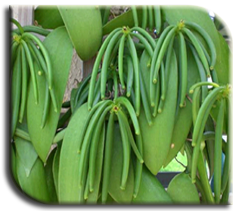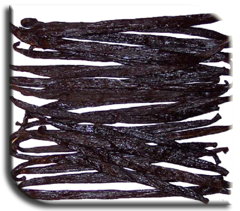VANILLA (Vanilla planifolia Lin)
Orchidaceae
Varieties
No named varieties
 |
| Vanilla Plantation |
Soil
Lateritic soil rich in humus having good drainage.
Climate
Humid tropical climate with an annual rainfall of 150 - 300 cms (well distributed for a period of 9 months and dry period of 3 months).
Elevation: 700 – 1500 m MSL and with latitude of 100 N and 200 S
Temperature: 210 C – 320 C.
Standards
Glyricidia sp, Erythrina indica, Jatropha curcus, Plumeria alba and Casuarina equisetifolia.
Planting during on-set of rain after summer during May and June.
Season for vanilla planting
6 months after planting standards (i.e.) September – October – November.
Propagation
Stem cuttings of 60 - 120 cm
Spacing
Planting
Pit size 30 cm3 for standards and for planting of vanilla cuttings. Place 2 nodes of unrooted cuttings of 60 – 120 cm below the soil surface.
Training
Train the vines to a height of 1.2 to 1.5 m. Then trained horizontally or allowed to grow downward towards the ground. Horizontally trained vines are coiled round the pole connecting the two supporting trees. Vines trained to grow downward is allowed to touch the soil and allowed to root and again brought back upward on the same supporting tree and the same procedure is repeated.
Manuring
Mulch the vine with pruned vegetation 2 – 3 times in a year.
Recommended dose of fertilizers:
Apply 40 – 60: 20 – 30: 60 – 100 g of NPK per vine per year. It is given in 2 to 3 splits. Spray 1 % solution of 17: 17: 17 NPK mixture once in a month for boosting growth and flower production.
Flowering
Flowering starts in the third year of planting during December – January. Pinching of top 7.5 – 10 cm of vine 6 – 8 months before flowering seasons encourages flower bud initiation. Pruning of older fruiting branches also encourages flower production. Each inflorescence consists of 15 – 20 flowers.
 |
| Vanilla Flowers |
Vanilla Flowers
Pollination
The artificial pollination is useful in vanilla and pollination must be done on the same day as flowers start opening from 4.00 am and extend upto 1.00 pm. About 10 to 20 inflorescence may be pollinated in a vine.
Normally 5 to 6 flowers in the lower side of inflorescence are pollinated. Hand pollination is done using a needle or a piece of pointed wood or a tooth pick to lift the hood covering the anther cap so that the anthers are brought into contact with stigma A skilled worker can pollinate 1000 – 1500 flowers in a day.
 |
| Vanilla Immature Beans |
Vanilla Immature Beans
Plant Protection
Pest
Leaf eating beetles, Feeding bugs and Caterpillars
Spraying quinolphos 0.05 %.
Diseases
Fusarium wilt
Infection starts in the axil of the leaf and spread to nodal region resulting in rot.
Phytophthora rot
It causes rotting of beans, leaves and stems.
Spraying Bordeaux mixture 1 % or soil drenching with Copper oxy chloride 0.2 %
Sclerotium rot
It occurs in root tips and later extends to whole root system followed by yellowing and wilting of
vines. Soil drenching of Carbendazim 0.1 %
Shoot tip rot and Sclerotium rot
Soil drenching of Carbendazim 0.1 %
Harvesting
The pods are ready for harvest in 6 to 9 months after flowering. The matured beans change colour from green to pale yellow. The right picking stage is when the distal end of the pod turns yellow. Daily picking of matured pod is essential. The pods are harvested by cutting with a knife.
Yield
-
Average cured bean yield is 300 to 600 kg / ha / year.
-
6 kg of green pods produces 1 kg of cured beans.
-
The economic life of vine is 12 – 14 years.
 |
| Vanilla Beans |
|




